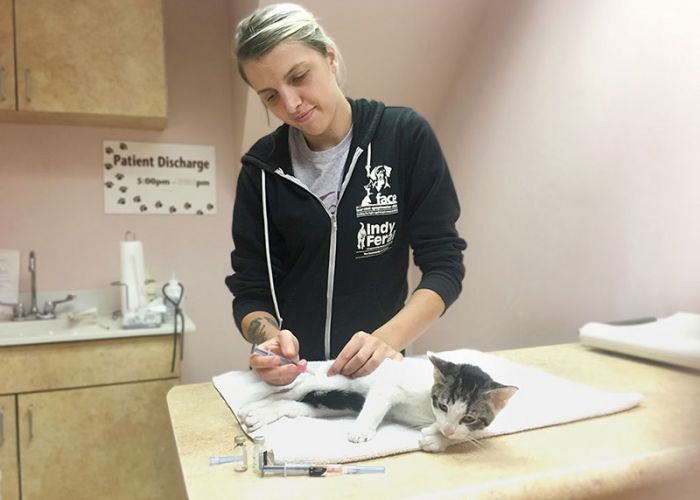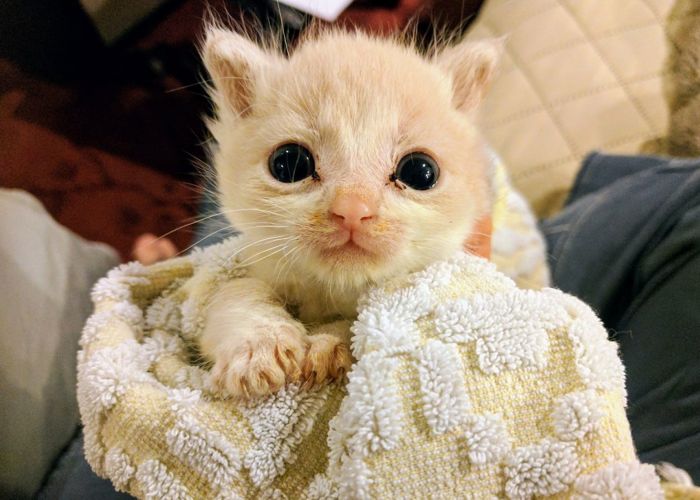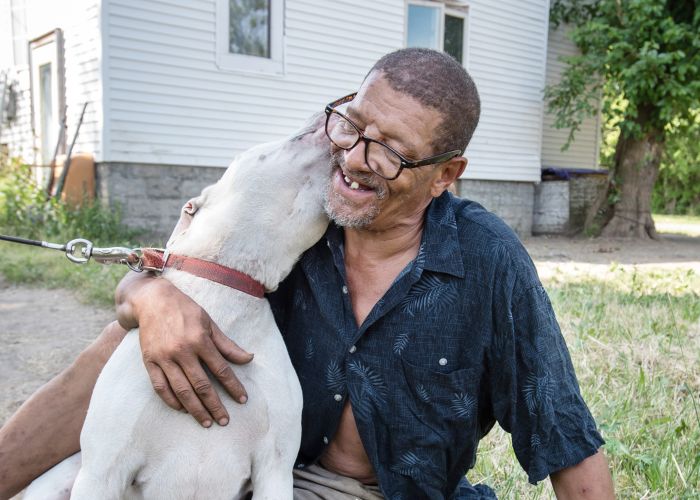Your building is a nightmare
...but your disease control doesn’t have to be

The heavy door creaks shut behind you as you enter a dim hallway. Above, the lights flicker and buzz, making your eyeballs ache. Passing through another shadowy hallway into a room, you feel a draft at the doorway and hear the rain falling outside. When you step into the room, water squelches around the broken tiles, releasing an awful smell. All around you, the cracked walls ring with the sound of howling.
It’s not Dracula’s castle. It’s your animal shelter.
Maybe it was built when poodle skirts were cool—or even when flappers were. Maybe it’s more recent, but has construction flaws that have revealed themselves, over the years, to be operations nightmares. And maybe you’re already working on a capital campaign to get the heck out of the place—but until then, you’re stuck with the worn, germ-attracting surfaces, the outdated drainage system and ventilation, and the jungle-like humidity they create.
You don’t, though, have to be stuck with constant disease outbreaks.
Smart facility design and smart operations are key to maintaining the health of shelter animals, and when a facility is deficient, the management side of the equation becomes even more crucial. Proactive daily operations to address sanitation and implement wellness protocols can help you maintain a healthy shelter environment—even in a building that gives you the creeps.
Go retro
Some problems in older facilities can be addressed by retrofitting certain areas. Exposed drain troughs, for example, can be covered with metal grates to minimize cross-contamination and treated to ensure that standing water and backups are kept to a minimum. The addition of skylights and windows may provide much-needed sunshine and fresh air, combating the dismal and germ-friendly effects of darkness and humidity. For retrofitting projects, consult with a design firm that has expertise in shelter construction.
Extremes or fluctuations in temperature can compromise animal health. Poor ventilation and high humidity favor the accumulation of infectious agents, while dust and fumes may be irritating to animals’ respiratory tracts. Retrofitting your facility with the ideal HVAC system may not be feasible, but here, too, it’s smart to consult with a specialist to maximize your facility’s existing HVAC system. If you’re years away from a new facility or ventilation system, practice savvy mitigation: Perform regular maintenance of filters and control dust and dander through routine cleaning, periodic deep cleaning and the use of dust-free kitty litter.
Regular maintenance and repairs can also help stave off the bugs that a shoddy building invites. Perform regular inspections, encourage staff to report issues they find around the building, and prioritize addressing them based on their impact on human and animal health and safety. For example, periodic resealing of floors and maintenance of plumbing fixtures can help reduce those germs that love to hide in cracks and the moisture issues that can develop from even minor leaks. Developing and following written standard operating procedures (SOPs) and daily, weekly, monthly and quarterly checklists can help ensure that maintenance schedules are carried out in a timely fashion.
People power and smart policy
Your strongest ally in making sure that your old building doesn’t get the best of you is a well-trained and capable staff.
For example, studies in the human health care field have repeatedly shown that handwashing is the most effective method of reducing disease transmission. Few older shelters have sinks in areas where staff can easily and frequently access them during their daily rounds, and while having a sink in every animal ward is ideal, it’s often impractical. But you can manage a middle-ground approach by placing hand-washing stations throughout the facility. This may be as simple as attaching hand sanitizer and glove dispensers to the walls, or consider placing portable, plumb-free sinks in key access points—and establishing cleaning and sanitation protocols that remind staff to use them.
Cleaning and sanitation protocols go far beyond hand-washing, of course. In addition to protocols for routine daily cleaning and disinfection procedures, you should establish written SOPs for periodic deep cleaning and disinfection as well as procedures to be used in the case of disease.
Remember that cleaning and disinfection are two separate processes that go hand in glove. Cleaning involves the removal of gross wastes and organic debris through the use of detergents, degreasers and physical action. This process should result in a visibly clean surface, but does not necessarily remove all the infectious agents that may be present. Disinfection will destroy most of these agents, but it cannot be accomplished until surfaces have been adequately cleaned.
Disinfection is usually accomplished through the application of chemical compounds or disinfectants. The products you use in your shelter should be chosen based on your specifics—types of surfaces, types of organic matters present, etc.—as well as their effectiveness against the pathogens for which the animals are at greatest risk.
To ensure proper disinfection, you also need to ensure adequate contact time for the solution followed by thorough drying of surfaces. Potassium peroxymonosulfate (sold under the brand name Trifectant or Virkon) is a particularly useful compound for cracked or porous surfaces; when properly applied, it is effective against bacteria and common shelter viruses including parvo and calici. Trifectant contains a detergent, so it can be used as the primary agent for both cleaning and disinfection, but you’ll still need to use a degreaser periodically to remove buildup of organic debris.
Another option is the use of accelerated hydrogen peroxide disinfectants, such as Oxivir, Accel or Rescue, that may require only a five-minute contact time and are similarly effective against significant shelter pathogens in the presence of organic material. Accelerated hydrogen peroxide products have the advantage of being safe and gentle on the environment.
Thorough cleaning and disinfection of enclosures should occur between cage occupants and as part of periodic deep-cleaning procedures. “Spot cleaning” is generally sufficient for cages with apparently healthy animals who will continue to occupy the same enclosure.
Whenever possible, have one staffer or team clean and care for animals in areas with highly susceptible animals, and another staffer or team clean and care for animals in the sick area. If this isn’t feasible, at a minimum, you can address the order in which separate areas are cleaned: The least contaminated areas and those holding the most vulnerable animals should be cleaned before areas that are most contaminated and holding less vulnerable (or already sick) animals. To minimize germ transmission, provide dedicated cleaning equipment for each area. Staff should wear protective clothing to prevent cross-contamination and keep their hands clean through a combination of hand-washing, sanitizers and the use of gloves (which should be changed between animals).

Traffic flow
Your aging building may not provide much space, but you can power-up your infectious disease control protocols by modifying the flow of human and animal traffic. Smart traffic patterns will help promote health and reduce the risk of disease transmission.
Many older buildings don’t have a designated space for animal intakes and exams. Typically, every animal will pass through either the front desk and/or an intake room, and those spaces will therefore have a high risk of harboring infectious disease. Consider, for example, whether you could adjust your flow so animals who are known to be sick enter through a separate door, directly into an isolation area. Or, because heavy foot traffic increases the spread of germs, could you retrofit an exam area close to where animals enter the building so that they do not have to be routed through multiple animal holding areas?
The intake area does not have to be a specialized examination room, but it should be quiet, enclosed and well-lit, and set up to minimize stress. The area should be easy to clean and disinfect, and have all supplies needed for a thorough examination. Vaccination against core diseases immediately at the time of intake successfully confers immunity in most animals and is an essential part of the intake process. Animals should not be housed in the intake rooms, as this sets up a potential for infectious disease transmission.
In isolation areas, attention to traffic patterns and the use of protective clothing—such as gowns and shoe covers—are essential. Footbaths are insufficient to prevent transfer of infectious agents on shoes since most disinfectants require 10 minutes of contact time and may be less effective if any organic debris is on the shoes. In fact, footbaths may even contribute to the spread of disease; it’s far preferable to use dedicated boots or shoe covers when entering contaminated areas—and remember, it’s best to have dedicated staff for these areas as well.
By design, traffic patterns should move from the healthiest and most susceptible animals (such as healthy kittens and puppies) to the least susceptible (healthy adults), and finally to isolation areas housing sick animals. Observation windows and signage are useful to reduce traffic flow into high-risk areas. Where space or facilities are not available, foster care may represent a viable and medically sound option for quarantine or isolation.

Separation smarts
You can minimize disease and maximize your space by smart separation of your animal population, moving animals into separate housing areas based on species, health, age and other factors. Minimally, these include:
- A healthy hold area, which houses stray and healthy owner-surrendered animals until they are reclaimed or moved to the adoption floor (keep in mind that length of stay is associated with an increased risk of infectious disease, so holding periods should be minimized whenever possible and within the confines of state laws);
- An adoption area, which houses healthy animals available for adoption;
- An isolation area, which houses animals who are clinically ill (symptomatic) and infected with a communicable disease (in an isolation space, the use of barriers and solid walls can lessen the transmission of disease);
- Quarantine areas, ideally one for animals considered potentially dangerous (such as animals who have bitten) and another for those who may be infectious (such as animals under rabies observation or who have been exposed to infectious disease but are not yet symptomatic).
Every facility needs to be able to separate animals into subpopulations to promote health, reduce stress and facilitate compliance with legal holding requirements. All facilities should minimally separate dogs (and cats) into the four groups described above; ideally, this means physically separate rooms or wards. Less ideally, you can use moveable barriers (such as the cubicle partitions common to office buildings) within spaces to distinguish the “healthy hold” area from the adoption area. These don’t provide true separation, but may help visually distinguish the areas for staff and visitors so they can direct their movements appropriately. You may need to analyze your current use of space with an open and creative mind. Once you decide on a plan, it can be helpful to label rooms or areas with their intended purpose.
Even within the same species, it’s usually best to separate animals by sex and reproductive status (e.g., intact, neutered, in heat, pregnant, nursing); physical and behavioral health status (e.g., apparently healthy, signs of contagious disease, shy/fearful, aggressive, etc.); and life stage. Kittens and puppies younger than 4-5 months are particularly susceptible to infectious disease, and extra care must be taken to limit their exposure. Geriatric animals require comfortable, quiet quarters with careful attention to stress reduction. Provide separate, quiet and low-stress housing for feral cats and aggressive dogs.
Even in less-than-ideal facilities, removing clinically ill animals from the general population is critical to limiting further disease transmission. When you’re setting up a space to contain contagious animals, keep in mind the wide variety of potential infectious diseases and the primary ways they can be transmitted. Ideally, you should set up multiple isolation areas to separate sick animals by age and type of illness (for example, a ringworm ward separate from a URI ward).
Older facilities are unlikely to have isolation rooms with separate ventilation systems. However, respiratory disease can usually be contained in a physically separate ward that is distanced from the healthy population. “Physically separate” means that the ward should have doors that close, and if the kennels have partial outdoor access, they should not share nearby outdoor air space with the healthy population.
Remember that healthy environmental conditions in isolation or quarantine areas promote recovery. Crowding, noise and stress must be avoided, and facilities must be easy to clean and disinfect. The room temperature should be warm and comfortable with good air quality. Windows are ideal, as natural sunlight is always beneficial to animal health and healing.
Older buildings often don’t include outdoor play areas for dogs, either. Often, you can create these spaces, but pay attention to the details. Dogs often rotate in succession through outdoor areas, and may thus be exposed to each other’s germs. Ideally, there should be an area for dogs less than 6 months separate from the space for adults. Many times, multiple smaller spaces (rather than one large one) will allow maximum usage, prevent large packs where canine personalities may not all match and provide the option to close off an area in the event of disease issues. The substrate used should be one that can be cleaned and disinfected regularly—sealed cement is typically best, though some shelters now use artificial turf successfully, and pea gravel can also be adequate. Grass and dirt can’t be fully sanitized and should be avoided in heavily trafficked play spaces (once contaminated by diseases such as canine parvovirus or some parasites, the situation can be difficult to remedy).
Crowd control
Adequate space and enrichment for animals are the bedrock of maintaining herd health. Many shelters are housing animals for longer periods of time and housing animals with more significant health and behavior concerns. Doing this in kennels that were constructed decades ago, even for short-term stays, can ultimately be inhumane.
Ensuring a modest population density is critical to disease control. Crowded conditions increase the odds of introduction and transmission of infectious disease. They also increase the magnitude of many environmental stressors—for example, noise levels are higher and air quality is lower in crowded conditions, which stresses animals and taxes their immune systems. Such conditions also tax caregivers, compromising the quality of care and further contributing to the risk of infectious disease.
Whether you’re considering upgrading your kennels and caging or simply trying to figure out the best use for the ones you already have, you should have an idea of how many animals your shelter has in its care on a daily basis. Typically, older facilities do not have the caging capacity to humanely house the expected numbers of animals, and until this minimum need is met, it can be difficult to function optimally in most other regards. Understanding the housing challenges up-front can be helpful for a shelter to plan alternate means of lessening overcrowding, which can potentially include ramping up foster care programs, contracting with local boarding kennels and in some cases changing intake or outcome procedures.
Ensuring efficient care is the key to maximizing your shelter’s lifesaving capacity. When animals move through the sheltering system efficiently, their length of stay is minimized, reducing their risk for illness and behavioral deterioration.
It can feel overwhelming to work in a building that predates you and most everyone on your staff. But while you’re waiting to relocate or upgrade, a commitment to cleaning and disinfection and smart approaches to managing separation, intake and traffic flow can help ensure that your facility doesn’t negatively impact your animals’ health—even if you still feel a little queasy looking at it.







